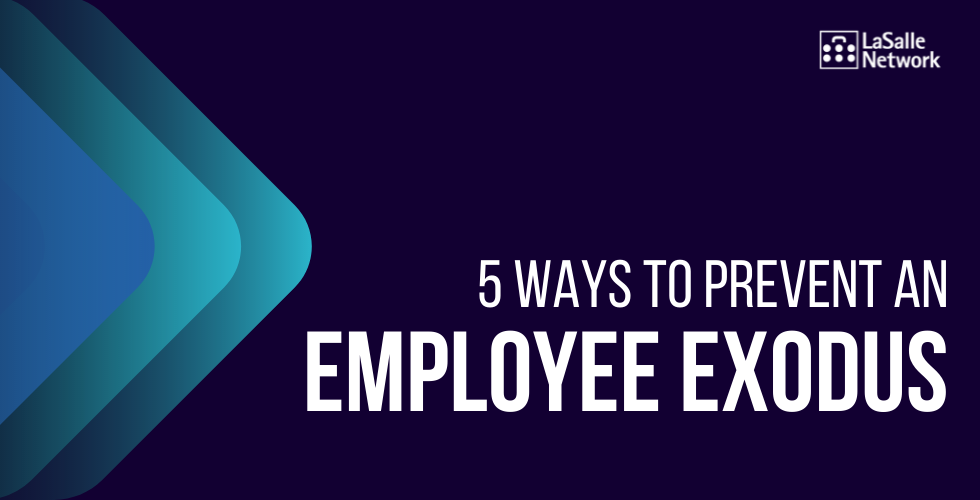According to a new SHRM report, more than half of employees surveyed in North America plan to look for a new job in 2021, and a quarter of workers plan to quit their jobs outright once the COVID-19 pandemic subsides. Deemed by some as “a Great Resignation,” the voluntary quit rate is predicted to skyrocket in the coming months after hitting its lowest level in the last 9 years in December 2020.
While employees resume job searches they put off for the past year, companies must begin now in preparing for and working to prevent a mass exodus of talent. Below are 5 essential considerations for business leaders to help hold on to top talent and prevent excessive turnover.
Start a dialogue.
Acknowledge that company leaders understand there has been a great deal of pressure and stress on employees over the last year and show appreciation for staff for sticking through such a challenging time. Recognizing employees for their hard work and dedication to the team, especially when times were tough, rather than focusing solely on results, can help employees feel valued and cared for.
Managers should regularly check in with employees on their well-being and ask what they can be doing to support them. They should ask employees not only what they need in the moment, but what they can be doing to help further develop them as professionals and how they can help push employees toward long-term career goals. Understanding employees’ long-term career goals can help strengthen connection and may lead to further development opportunities within the company, versus employees feeling they need to look elsewhere to continue in their professional development.
Watch for signs of burnout and address it quickly.
Rates of burnout have continued to rise in 2021, even as compared to spring and summer 2020, leading to 76% of American workers now experiencing burnout. Heavy workloads during the pandemic, balancing work and personal lives and a perceived lack of communication, feedback and support from employers may be contributing to these burnout rates and leading to a spike in resignations.
If left unaddressed, burnout may cause employees to lose interest and motivation, decrease productivity and creativity, and can lead to turnover. Signs that an employee may be heading toward burnout include exhaustion, irritability, lack of creativity, lack of participation, increased mistakes, and negativity. While burnout may look different for different people and these signs do not always mean an employee is at risk for burning out, they can serve as good indicators to reach out and learn more.
If you notice an employee approaching or experiencing burnout, the first step is to address it. Explain you’re noticing a change in mood and behavior and ask them if there is anything going on outside of work (or with their work) that is impacting them. Continue to keep an open line of communication and consider switching up or redistributing some tasks, as necessary. Identify what motivates this employee, for example, public recognition or friendly competition, and work with them to help regain their momentum. For more ideas on mitigating the impacts of burnout, click here.
Build in connection points.
People often stay with a company longer if they feel connected to their teammates, to the broader organization, and to the mission of the company. With a large portion of the workforce operating from home, it’s possible that relationships may have weakened and employees may be rarely interacting with anyone outside of their immediate team. Connectivity for many companies has been a challenge while operating remotely, and rebuilding or cultivating new connection points now will be essential to retaining many employees.
Having more culture building events across various teams can help to rekindle connectivity, reintroduce peers to one another, and reinvigorate company culture, all while still working remotely or easing back into in-office work. Consider implementing more regular virtual events such as Friday afternoon virtual happy hours, virtual celebrations such as birthday parties or wedding showers, and potentially some small in-person meetups. For 120+ ideas of effective and fun virtual events to help maintain culture and camaraderie, click here.
Provide opportunities for growth.
In a LaSalle Network survey of more than 2,000 professionals, lack of opportunity for growth was one of the top three reasons talent was open to new opportunities. Employees want to be challenged and develop their skills, and may get bored or feel trapped in a role if opportunities for advancement are not apparent. Consider how to invest in employee learning and development in order to retain talent.
Consider the value of a mentorship program for more entry level employees to learn from more tenured employees. Beyond providing mentorship, these programs may also help foster connectivity and teach employees about different areas of the business.
LaSalle Network has coined the term ‘corporate grandparenting’ as a form of mentorship in which corporate grandparents help guide not only their direct reports, but the layer of staff below their direct reports as well. For example, someone at the executive level can set up a short, regularly occurring call with a director–level employee that reports up to one of their Vice Presidents. Learning from a skip-level manager can help develop proven performers into future leaders. This kind of mentorship can provide guidance and perspective of how the employee is contributing to the larger organization, while making them feel valued. This can help improve retention by ensuring employees feel invested in and see a more well-rounded picture of how they could grow their career within the organization.
Consider your return–to–office policy.
Companies that have operated partially or entirely remote and are now beginning to bring employees back into the office should consider how this may contribute to turnover. For some, coming back into an office may be especially difficult for various reasons such as having moved, taken on additional personal responsibilities such as caring for children or elderly family members, and more. For others, there may be a great deal of fear or health concern surrounding returning to the office. Consider how to best accommodate those of differing situations, if possible, to avoid losing valuable talent.
Implement a positive communication plan in which employees can submit questions or feedback anonymously regarding the return to office to help them feel more comfortable and supported. Human Resources or other company leaders should address these concerns company-wide while communicating return-to-office plans and present as much detail as possible regarding how employees will be kept safe and what expectations will be. Minimizing fear and uncertainty regarding returning to the office may help retain employees who otherwise would consider leaving for fully remote opportunities.
While some degree of turnover may be inevitable, leaders should begin planning now to prevent turnover from spreading and to hold on to their most valuable talent. Consider also if the influx of professionals preparing to leave their current companies could present an opportunity to gain human capital and recruit valuable talent from competitors. While the upcoming months present certain challenges for employers, it may also be an opportunity to grow and attract much-needed talent.
If adding headcount is a part of your plan, let us help. Get connected with us here.





